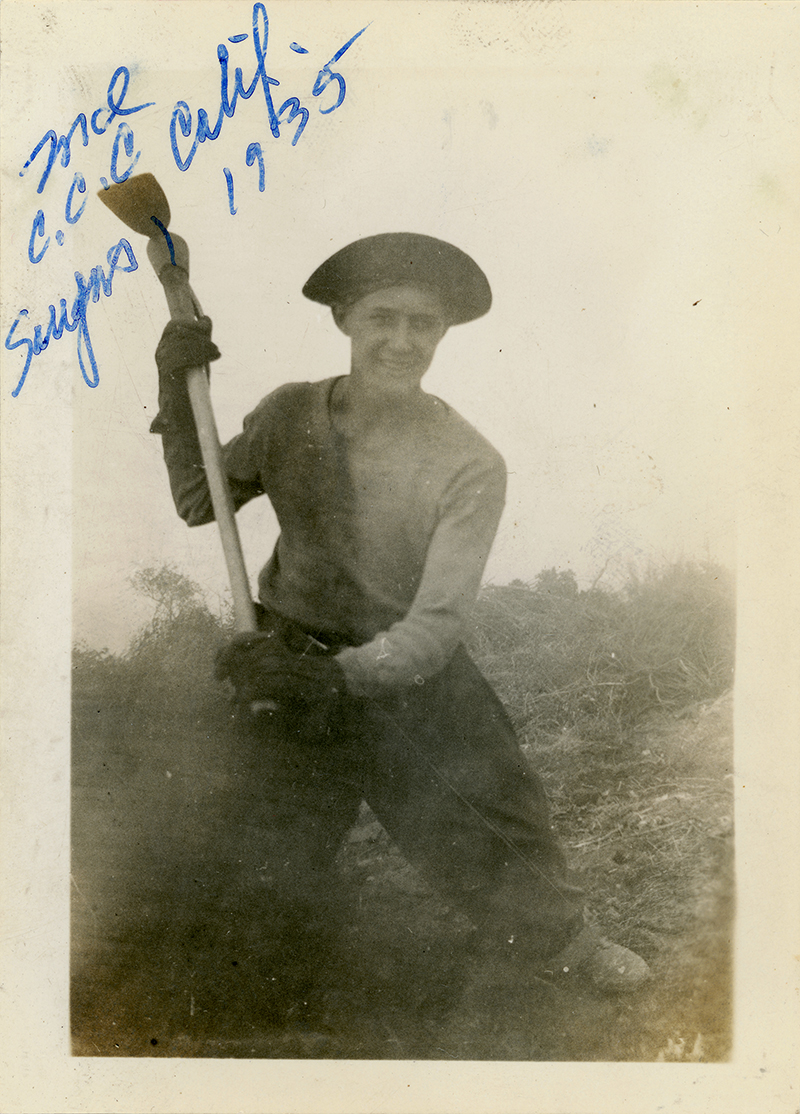|
|


Click image to enlarge
A CCC enrollee at work, probably on the Santa Clara Divide. Apparently this man is responsible for this set of photographs from the Civilian Conservation Corps (CCC) Camp at Bear Canyon, Saugus. Handwriting on front of photograph reads: "Me / C.C.C. / Saugus, Calif. / 1935." Handwriting on back of photograph reads: "At work 5,000 feet above sea level on the Santa Clara firebreak. Longest stretch of mountains in California." Print date-stamped Feb. 1 (no year).
One in a set of eight tiny, 2x3-inch personal photographs (2.5x3.5 inches, including margins) from an unknown source — apparently a man who was an enrollee with CCC Company 1647 at "Bear Canyon, Saugus" in 1935-36 — and purchased from a third-party vendor who acquired them at a collectibles show in Portland. There is some indication the CCC enrollee traveled between Saugus and Idaho. The CCC Bear Canyon/Saugus camp was located east of Sand Canyon Road in Iron Canyon, at the present-day intersection (east side) of Iron Canyon Road and Knochaven Street. Camp crews evidently worked on a 3-month rotation; another CCC company, No. 551, was assigned to the Bear Canyon location in 1933-34. Read more about the CCC Bear Canyon/Saugus camp location here.
About the Civilian Conservation Corps.
With unemployment at 25 percent in the fourth year of the Great Depression, Congress granted President Franklin D. Roosevelt emergency powers less than a month after he took office. Days later, on April 5, 1933, FDR created the Civilian Conservation Corps by executive order. Considered one of the more popular New Deal programs, its goal was to employ young men to plant trees and arrest the destruction of America's natural resources. By late 1935, more than 2,650 camps were operating in all 48 U.S. states including more than 150 in California. They operated at the direction of different federal and state agencies. Locally, camps were established under U.S. Forest Service control in Acton (which became Acton Rehab), Agua Dulce (north of town in the Sierra Pelona foothills), Oak Flat (Castaic area), Elizabeth Canyon and Bouquet Canyon (per Jerry Reynolds), Bear Canyon/Saugus (Iron Canyon), Wildwood Canyon (near Newhall-Happy Valley), Mt. Pinos and maybe elsewhere. Most unemployed youth were in the east, while most of the projects were in the west. They earned $30 per month and sent $25 of it home to their families. Nationally from 1933-1942, more than half a million enrollees planted more than 3 billion trees, erected 3,470 fire towers, built 97,000 miles of fire roads, fought fires and floods, performed erosion control, and created parks — including, in California: Big Basin, Mt. Diablo, Mt. Tamalpais, Pfeiffer Big Sur, Cuyamaca Rancho and more. The CCC also rebuilt the La Purísima Mission near Lompoc in one of the country's largest historical restoration projects. Locally, CCC enrollees built fire lookout towers, cut fire roads, fought forest fires, strung telephone lines, replaced washed-out bridges, contoured slopes, built campgrounds in Bouquet Canyon and the Elizabeth Lake area, and even developed wildlife refuges and stocked fish in the Bouquet Reservoir.
LW2909: 9600 dpi jpeg from original photograph purchased 2017 by Leon Worden.
|
The site owner makes no assertions as to ownership of any original copyrights to digitized images. However, these images are intended for Personal or Research use only. Any other kind of use, including but not limited to commercial or scholarly publication in any medium or format, public exhibition, or use online or in a web site, may be subject to additional restrictions including but not limited to the copyrights held by parties other than the site owner. USERS ARE SOLELY RESPONSIBLE for determining the existence of such rights and for obtaining any permissions and/or paying associated fees necessary for the proposed use.










